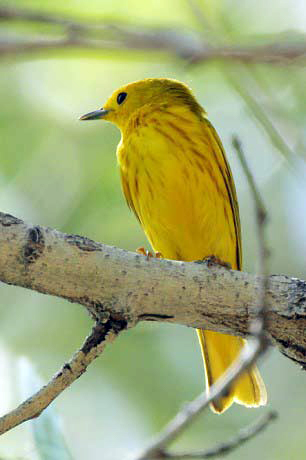Bird populations can be affected directly or indirectly by natural forces and disturbances, as well as by human activities and park management decisions.

Photo © Robert Shantz
Ecosystems are driven by an interaction of many factors, including regional climate, natural disturbances, anthropogenic stressors, and species-specific attributes that can affect species abundance and overall community patterns (Holmes and Johnson 2007). Natural forces include regional climatic and atmospheric conditions, such as precipitation and wind; and natural disturbances, such as extreme climatic events (e.g., drought, flood), fire, disease, insect outbreaks, herbivory, and trampling (Holmes and Johnson 2007). Disturbances, for example, can directly affect the survival and productivity of bird species, and they can affect bird species indirectly through habitat effects. Anthropogenic stressors (e.g., habitat fragmentation, fire suppression or exclusion) can affect birds by altering the structure and function of ecosystems (Holmes and Johnson 2007).
One of the primary goals of monitoring birds is to detect change over time, and to use this information to understand the state of the parks’ ecosystems. Monitoring in the NPS is intended to aid in the development of broadly based, scientifically sound information on the current status and long-term trends in the health, composition, structure, and function of park ecosystems. Because birds respond to environmental features in predictable ways, monitoring concurrent changes in bird populations and habitat features can provide NPS managers with information they need to assess their actions.
For instance, semi-desert grasslands throughout the American Southwest are being affected by the encroachment of mesquite and other shrubs into areas once dominated by perennial grasses. Grassland-obligate birds have responded predictably to this change in structure--their local populations are declining. Identifying the percent and area of shrub encroachment into the semi-desert grassland can provide both an early warning of changes to bird communities and a target threshold of encroachment that managers can use to take action (e.g., fire use or mechanical treatments).
Both population-based and community-based monitoring projects are being conducted in the Southwest. For example, in the Sonoran Desert Network, managers have chosen three avian population parameters to estimate and monitor landbirds: density, relative abundance, and occupancy. Each parameter has different properties that vary in terms of the quality of information gained and the estimated cost of measurement. Density is the most desirable parameter and facilitates estimates of total population change (e.g., number of individuals lost or gained) over time. Relative abundance provides an estimate of the ratio of overall population change among years; because this parameter has drawbacks related to variation in detectability, it will be measured only when density estimates are not possible. Occupancy, especially useful when monitored along with density, will allow us to monitor changes in the number of sampling units occupied by a species over time (i.e., presence or absence) and allows adjustments for imperfect detectability during estimation (MacKenzie et al. 2002). The field methods (the point-transect distance-sampling method at fixed points) used for estimating all three parameters will be the same, although the analyses and evaluation procedures used to estimate trends will differ.
In the Southern Colorado Plateau Network, bird communities were chosen for monitoring as an indicator of the overall condition of upland and riparian ecosystems. The bird monitoring focuses on several habitats where integrated upland or riparian monitoring is also occurring. The bird community monitoring consists of breeding season surveys that use variable circular plot methodology. At each sampling point, an eight-minute survey is performed. Observations of birds by sight or call are recorded. Related habitat monitoring includes ground cover, canopy closure, vegetation cover, and forest structure attributes. In upland habitats, nest success for selected breeding species may also be monitored.
The management response to changes in bird populations and communities will vary, depending on the type and severity of the change and its underlying cause. In some cases, however, the link between changes in bird populations and other environmental features may simply be unknown, either because the cause of change within the park is not perceptible or because the environmental change is taking place outside park boundaries. Cross-boundary issues and other factors are making cooperation among land-management entities increasingly necessary, and NPS officials are actively engaged in these efforts. As these large-scale partnerships develop, so too will tools for landscape-level restoration that may positively influence bird populations and communities.
In general, threats to landbird communities in the American Southwestern are both numerous, and growing in extent and severity. Current and future stressors and drivers of regional bird communities include global climate change and diseases, such as West Nile virus.
For more information...
Learn about long-term monitoring of birds in southwestern I&M network parks:
Chihuahan Desert Network
Sonoran Desert Network
Southern Colorado Plateau Network
Southern Plains Network
Prepared by Patty Valentine Darby, Southern Plains Network Inventory and Monitoring Program, 2009.
Part of a series of articles titled Birds of the American Southwest.
Last updated: February 3, 2015
